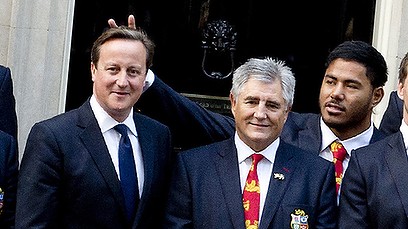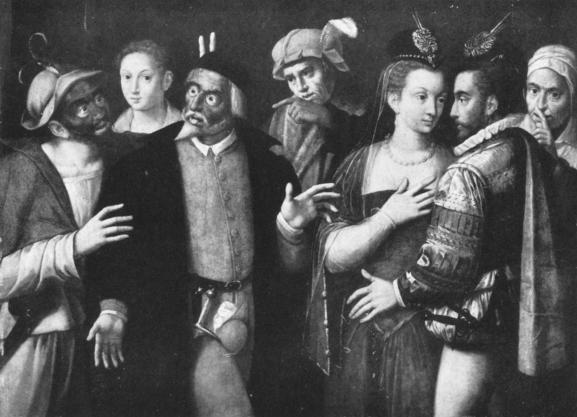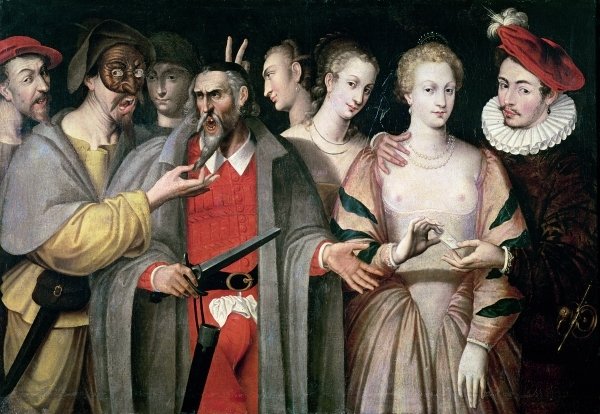The Cuckold’s Horns May 16, 2014
Author: Beach Combing | in : Medieval, Modern , trackback***Thanks to Ricardo and Neil for help with this post***
The cuckold’s horns is a sign, usually indicated by two fingers placed over the head, of a man whose wife has been unfaithful. In many countries – not least the UK, see photo – the actual symbolism has been forgotten and only the offence remains. This blogger went to a secondary school where it was felt to be hilarious to ruin a photograph by sneaking fingers over a fellow’s head, but none of the eleven and twelve years involved had the slightest idea what a cuckold was; in fact, they had no idea what a girl was, but that’s another and a far more depressing story.
How old is the symbol and more importantly what have horns got to do with fooled spouses? As to age it would be nice to report that it stretches back into antiquity, but there are no convincing Greek or Roman references. While there is enough Greek and Roman material surviving for us to put together a fairly impressive list of classical hand signs: for example, a Roman scratching his ear at a man, implies the man is gay.
However, the cuckold’s horns are definitely there in the Middle Ages. That great medievalist Peter Dronke noted a reference in the late 1100s in the work of Bernart de Ventadour. The earliest image of the cuckolded husband apparently dates, meanwhile, to a fourteenth-century French manuscript (of Gratian’s Decretals), where a husband is shown with antlers on: frustratingly I’ve not been able to examine the image, I’ve just read about it. The earliest surviving finger horn is, instead, perhaps in the two images above: the first Flemish, the second French. The second, a copy, is a work by Francois Bunel (not Brunel as found in several references!): thanks to Neil H for the correction and the dating. C. 1580 for the first and 1580-1587 for the second. The renaissance was obssessed with cuckolds, far more so than the middle ages: not sure why.
The most difficult question is, of course, where does the idea of a cuckold’s horns originate? There are many theories but the best notion has to be that pushed a generation ago by Graber and Richter (1987). They referred to a curious agricultural custom whereby castrated roosters (capons) had their spurs transplanted onto their combs: where they grew into the comb as horns. (Talk about adding insult to injury.) The cuckolded husband is neutered, hence the capon’s horns. If all this sounds interesting but hardly cuckoldish, consider that the German word for cuckold is Hahnrei (rooster-deer): etymological proof always sounds so convincing. The problem is that most studies suggest that the practice originated in the Latin Mediterranean (i.e. that’s where we get most early evidence) but the connection there was with goats not roosters… Awkward. Any other quarter credible theories: drbeachcombing At yahoo DOT com
Also an afterthought. The picture above suggests that the finger horns can take various forms. Is it possible that the two fingers evolved in Britain into the two finger insult?
16 May 2014: Chris S writes in ‘I did take a peek at that W site, and it’s alleged (but cited) theory is the horns are references to deer. Those comely does are fickle sorts, having no time for losers and rolling in the hay with any buck who can best her mate. On the other hand, my cursory inquiry into the mating habits of cervidae show females are like poker chips, with no say in the matter. Anthropocentrism coloring that hypothesis, obvs. In Caesar’s Unicorn it was mentioned ‘bos’ was a catch-all for hooved animals. Maybe goats were funnier than deer, and the tradition endured?’ Thanks Chris. I think the problem with the deer theory, as with many is that the horns are applied to the man not to the woman.
18 May 2014: Neil writes in with this fascinating email: I disagree on one point, but I’ll write a subsequent post because I find it so interesting. ‘Thanks for the credit for the Bunel, and for the articles and forgive me for being dubious but it’s what I do. I remember the gesture at school too, but it was “rabbit’s ears” – i.e., a bit thick, certainly not reproductive or, for cuckolds, non-reproductive.(1) I think the two fingers gesture is a great deal more complex. I share your doubts about the relevance of curious additions to cocks’ heads in Italy. It fits symbolically but not historically and there is no mechanism. Or at least, it fits the early associations of cuckolds with horns in England which are often not pairs, but there is no mechanism, but it doesn’t fit the later reverse V sign, for which there is a mechanism, on which more later. I speculate as follows, expanding on your post: Cuckolds, like the poor, have always been with us. In early modern England I would connect the prominence of cuckolds to the concerns about the change in social roles, which is played out in the church courts, in which adultery is an offence against social order, and in local actions against couples where traditional gender roles were reversed (e.g., skimmingtons). The cuckold was not just a figure of fun but actually a representative of a danger to the fabric of society, because a married man was supposed to control his wife. In this context the symbolism of the horn on the woman in the True and Certaine Discourse (1588) in McEachern needs no help from Sigmund Freud. The horn is not with the man but with the woman. The finger gesture demonstrates that the man’s horn is not where it should be, whether it is one or two fingers. Chris S’s comment may be relevant here; does mate with whichever male is dominant at any one time, which may be sequential, and the penultimate male is usually run off by the dominant one, which is a good symbol for the cuckold. Early modern England was also fertile ground for the creation, or adoption, of symbols. There seems to have always been a distinction between the English and the continentals as to the number of fingers required to insult someone (2). I have been trying to find authoritative evidence of when Commedia del Arte players first came to England. There is a secondary reference to Italian players in London in 1566, and better evidence for the 1570s. Assuming the paintings date to the 1580s it is reasonable to assume the gesture was on stage a decade or so before. Even without direct evidence I think it’s reasonable to say that there was enough transmission of ideas between Italy and England (e.g., John Florio) to make the theatrical gesture known, without a performance in England. The two questions are whether the gesture (a) was original stagecraft or use on stage of a gesture used in Italy and (b) was it in use in England before that?(3) Enough for now. Neil (1) The great FOAF of school photographs was the boy who ran from one end to the other to appear twice. I assume it’s a myth. (2) Which brings to mind the wonderful chapters in Rabelais in which the English scholar Thaumast contests with Panurge by gestures alone (Book 2 Chapter 19) which includes the English V sign and Panurge is counselled on marriage and the inevitability of cuckoldry (Book 3 Chapter 28) which in the Urquhart translation includes “have you no remedy nor salve against this malady of garffing horns in heads?” (3) I would be interested to know the earliest representation of cuckold’s horns in England – and how many fingers are used.’ Thanks, Neil!
21 July 2015: Elia writes in with this linked BBC article. This is a crucial passage.
The word derives from old French for a cuckoo (“cucu”). The females of some species of cuckoo lay their eggs in other birds’ nests and leave them to bring up the offspring. So, with that whiff of unfaithfulness, the carefree bird gave us the word “cuckold”, which came in the Middle Ages to mean a husband with an errant wife. But there are more subtleties in that rude gesture. The word “cuckold” also implies that the husband is unaware of his wife’s infidelities. And he might only find out on the arrival of a baby – palpably not his. Which takes us back to the cuckoo. References to cuckolds abound in English literature. In centuries past, marital infidelity was good for laughs. Such as in Chaucer’s The Miller’s Tale, in which a young suitor comes up with the most convoluted scheme to entice his young lover away from her suspicious, elderly husband. “For she was wild and young, and he was old, And deemed himself as like to be a cuckold.” Shakespeare loved cuckolds – many of his characters suspected they had become one. Cue anger, jealousy, murder and, of course, comedy. The word was also an excellent insult… “crooked-pated old cuckoldy ram” is one of the more colourful.





